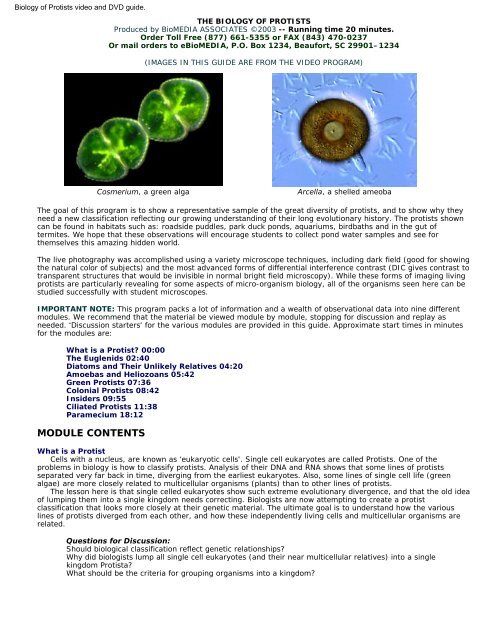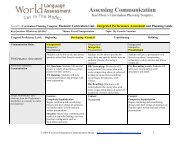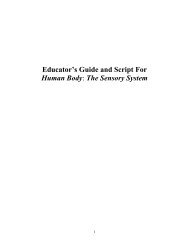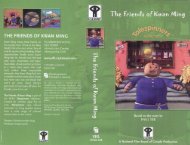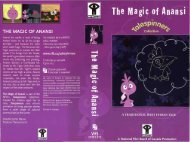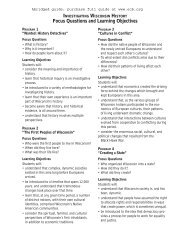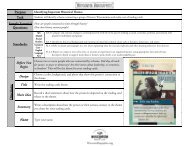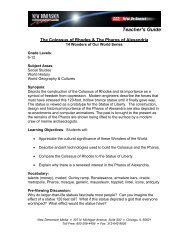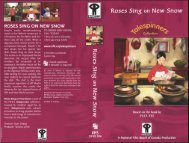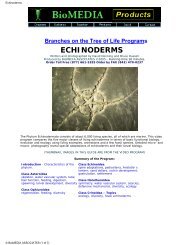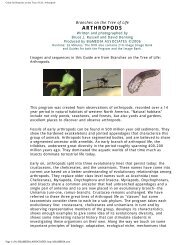Biology of Protists video and DVD guide. - ECB
Biology of Protists video and DVD guide. - ECB
Biology of Protists video and DVD guide. - ECB
Create successful ePaper yourself
Turn your PDF publications into a flip-book with our unique Google optimized e-Paper software.
<strong>Biology</strong> <strong>of</strong> <strong>Protists</strong> <strong>video</strong> <strong>and</strong> <strong>DVD</strong> <strong>guide</strong>.THE BIOLOGY OF PROTISTSProduced by BioMEDIA ASSOCIATES ©2003 -- Running time 20 minutes.Order Toll Free (877) 661-5355 or FAX (843) 470-0237Or mail orders to eBioMEDIA, P.O. Box 1234, Beaufort, SC 29901–1234(IMAGES IN THIS GUIDE ARE FROM THE VIDEO PROGRAM)Cosmerium, a green algaArcella, a shelled ameobaThe goal <strong>of</strong> this program is to show a representative sample <strong>of</strong> the great diversity <strong>of</strong> protists, <strong>and</strong> to show why theyneed a new classification reflecting our growing underst<strong>and</strong>ing <strong>of</strong> their long evolutionary history. The protists showncan be found in habitats such as: roadside puddles, park duck ponds, aquariums, birdbaths <strong>and</strong> in the gut <strong>of</strong>termites. We hope that these observations will encourage students to collect pond water samples <strong>and</strong> see forthemselves this amazing hidden world.The live photography was accomplished using a variety microscope techniques, including dark field (good for showingthe natural color <strong>of</strong> subjects) <strong>and</strong> the most advanced forms <strong>of</strong> differential interference contrast (DIC gives contrast totransparent structures that would be invisible in normal bright field microscopy). While these forms <strong>of</strong> imaging livingprotists are particularly revealing for some aspects <strong>of</strong> micro-organism biology, all <strong>of</strong> the organisms seen here can bestudied successfully with student microscopes.IMPORTANT NOTE: This program packs a lot <strong>of</strong> information <strong>and</strong> a wealth <strong>of</strong> observational data into nine differentmodules. We recommend that the material be viewed module by module, stopping for discussion <strong>and</strong> replay asneeded. “Discussion starters” for the various modules are provided in this <strong>guide</strong>. Approximate start times in minutesfor the modules are:What is a Protist? 00:00The Euglenids 02:40Diatoms <strong>and</strong> Their Unlikely Relatives 04:20Amoebas <strong>and</strong> Heliozoans 05:42Green <strong>Protists</strong> 07:36Colonial <strong>Protists</strong> 08:42Insiders 09:55Ciliated <strong>Protists</strong> 11:38Paramecium 18:12MODULE CONTENTSWhat is a Protist.... Cells with a nucleus, are known as “eukaryotic cells”. Single cell eukaryotes are called <strong>Protists</strong>. One <strong>of</strong> theproblems in biology is how to classify protists. Analysis <strong>of</strong> their DNA <strong>and</strong> RNA shows that some lines <strong>of</strong> protistsseparated very far back in time, diverging from the earliest eukaryotes. Also, some lines <strong>of</strong> single cell life (greenalgae) are more closely related to multicellular organisms (plants) than to other lines <strong>of</strong> protists..... The lesson here is that single celled eukaryotes show such extreme evolutionary divergence, <strong>and</strong> that the old idea<strong>of</strong> lumping them into a single kingdom needs correcting. Biologists are now attempting to create a protistclassification that looks more closely at their genetic material. The ultimate goal is to underst<strong>and</strong> how the variouslines <strong>of</strong> protists diverged from each other, <strong>and</strong> how these independently living cells <strong>and</strong> multicellular organisms arerelated.Questions for Discussion:Should biological classification reflect genetic relationships?Why did biologists lump all single cell eukaryotes (<strong>and</strong> their near multicellular relatives) into a singlekingdom Protista?What should be the criteria for grouping organisms into a kingdom?
<strong>Biology</strong> <strong>of</strong> <strong>Protists</strong> <strong>video</strong> <strong>and</strong> <strong>DVD</strong> <strong>guide</strong>.Amoebas <strong>and</strong> Heliozoans (05:42).... This observational module shows amoeboid protists moving <strong>and</strong> feeding by the extension <strong>of</strong> pseudopodia. All <strong>of</strong>the amoeba observations are in real time. Shell-building amoebas are common <strong>and</strong> the two shown (Arcella <strong>and</strong>Difflugia) are the shelled amoebas most <strong>of</strong>ten seen in pond water samples..... Heliozoans have long been classified with the amoebas, but genetic analysis places them on their own limb <strong>of</strong> theeukaryote tree. Their spines, made <strong>of</strong> microtubules, are <strong>of</strong>ten broken by a thrashing prey, but are quickly rebuilt.Question for Discussion:Does it appear that the diatoms ingested by the amoeba have undergone digestion, or do their glasscases protect them from digestive enzymes.How do amoebas move?Is there more than a single method <strong>of</strong> amoeba movement?How does a heliozoan’s spines actually trap prey?Spirogyra zygotesGreen <strong>Protists</strong> (07:36).... In unpolluted habitats it is common to find a diversity <strong>of</strong> unicellular green algae including crescent-shapedClosterium, a brilliant green cell with dancing crystals <strong>of</strong> gypsum in vacuoles at its tips..... Spirogyra is a filamentous alga composed <strong>of</strong> barrel-shaped cells with a b<strong>and</strong> shaped chloroplast that spiralsaround the cell. Conjugation in Spirogyra usually occurs before seasonal disruption <strong>of</strong> the habitat. Conjugation resultsin zygotes that will assure a new population <strong>of</strong> Spirogyra when conditions improve.Questions for Discussion:What is causing the gypsum crystals to dance?Are there male <strong>and</strong> female str<strong>and</strong>s <strong>of</strong> Spirogyra?What environmental factors might trigger conjugation in Spirogyra?Volvox eggsVolvox, daughter colony developmentColonial <strong>Protists</strong> (08:42).... Colonial green protists let us imagine how simple plants evolved from single-celled green protists. In the samedrop <strong>of</strong> pond water you can find: small colonies such as Gonium--usually with 16 cells; Eudorina--a 32 cells colony;<strong>and</strong> the queen <strong>of</strong> colonial protists--Volvox, with thous<strong>and</strong>s <strong>of</strong> flagellated cells lining the sphere..... Volvox shows the beginnings <strong>of</strong> cellular differentiation, a key event in embryology <strong>of</strong> multicellular organisms.Within the Volvox colony germinal cells divide, producing daughter colonies that break out in an asexual cycle thatrepeats generation after generation. As winter comes on some daughters will produce packets <strong>of</strong> sperm, others eggs.The result <strong>of</strong> fertilization is a thick walled zygote that will carry Volvox through freezing <strong>and</strong> drying.Questions for Discussion:How would you explain the appearance <strong>of</strong> Volvox in temporary rain pools (vernal pools)?Aside from difference in size <strong>and</strong> number <strong>of</strong> cells how does Volvox differ from Gonium?What survival advantage might have driven the evolution <strong>of</strong> colonies from single cells?
<strong>Biology</strong> <strong>of</strong> <strong>Protists</strong> <strong>video</strong> <strong>and</strong> <strong>DVD</strong> <strong>guide</strong>.Vorticella, contractile stalkVorticella group on duckweed rootletUrocentrumUrocentrum turbo, has a unique method for remaining in choice feeding areas. Urocentrum’s trick isan invisible tether line that it attaches to some nearby object.(Q. - How is Urocentrum able to compete with other bacteria feeders such as Vorticella <strong>and</strong>Paramecium?)\Urocentrum, linked by tethersStentorStentorThere are many Stentor species (several are shown). Like other ciliates, stentors join at their mouths<strong>and</strong> exchange micronuclei in a form <strong>of</strong> sexual behavior known as conjugation.Q. - In large Stentor species the macronucleus appears as a string <strong>of</strong> beads. Can this configurationbe functional?TrichodinaTrichodina lives as a commensal on Hydra, feeding on the bacteria that collect around hydra'sregurgitated meals. Trichodina hangs on by means <strong>of</strong> an amazing adaptation--a multi-toothed basaldisc.Q. - What advantages might Trichodina derive by living on Hydra? Could Hydra derive any benefitsfrom its guests? How might the protist be harmful to its host?Trichodina attachment diskColeps feeding on Paramecium carcassColepsNo community would exist for long without scavengers, <strong>and</strong> in the microworld Coleps is the Jackal.These are feasting on a paramecium carcass.Q. - How does Coleps attach in order to ingest food?
<strong>Biology</strong> <strong>of</strong> <strong>Protists</strong> <strong>video</strong> <strong>and</strong> <strong>DVD</strong> <strong>guide</strong>.SuctoriansLooking in pond water you may find a ciliate that has no ciliaÑa suctorian. Upon contact, thesuctorian’s tentacle tips fuses with the prey’s membrane <strong>and</strong> with some pressure adjustments, thesuctorian sucks in its meal. Suctorians exhibit the very unprotist-like behavior <strong>of</strong> giving birth. As theciliated larva emerges from the birth pore, it turns on the power--a response that helps it avoidtouching its mother's tentacles.Q. - Why do biologist place suctorians (organisms without cilia) on the ciliate line <strong>of</strong> evolution?DidiniumDidinium has an appetite for just one type <strong>of</strong> prey--Paramecium. It takes Didinium approximately 40seconds to swallow a Paramecium. In a laboratory dish, the feeding frenzy will continue until nearlyall the paramecia have been eaten. With no more food, the didinia form cysts, lying dormant whilethey wait for a new population <strong>of</strong> paramecia to build up.Q. - In a pond, how can Paramecium, which normally does not encyst, avoid being wiped out by aDidinium attack? What might signal an encysted Didinium that it is time to excyst <strong>and</strong> go hunting?Paramecium (18:12).... Paramecium can be cultured by adding some boiled hay (or dry grass clippings) to pond, or aquarium water.Paramecium, excretory crystalsDidinium attacks a Paramecium.... With plenty <strong>of</strong> organisms to examine one can observe:• How Paramecium feeds on bacteria by phagocytosis <strong>and</strong> digests them in food vacuoles.• How the cell gets rid <strong>of</strong> water entering by osmosis by means <strong>of</strong> its contractile vacuoles.• How it eliminates undigested material through its anal pore.• How it deals with metabolic wastes by crystalizing them.• How it avoids getting trapped in microscopic mazes.• How it reproduces asexually, with division <strong>of</strong> its macronucleus <strong>and</strong> the duplication <strong>of</strong> its variousorganelles. Periodically, Paramecium enters into a sexual process, whereby individuals fuse togetherat their oral grooves <strong>and</strong> exchange micronuclei. This mixing <strong>of</strong> genes revitalizes the Parameciumpopulation which can then continue on reproducing asexually for hundred <strong>of</strong> generations..... To learn more about these fascinating organisms, collect water from local sources. Jars <strong>of</strong> pond water that containsome decaying vegetation <strong>and</strong> kept at room temperature for several days will <strong>of</strong>ten teem with populations <strong>of</strong> protists..... To identify organisms found in natural collections we recommend the classic How to Know the Protozoa by T.L. Jahn, <strong>and</strong> Guide to Microlife by Rainis <strong>and</strong> Russell..... To further explore the lives <strong>of</strong> these fascinating organisms see The MicroNaturalists Notebook, a monthly featureon our web site eBioMEDIA.com..... A full listing <strong>of</strong> the <strong>Biology</strong> <strong>of</strong>--- series <strong>video</strong> <strong>and</strong> <strong>DVD</strong> programs (18 topics, from Viruses to Chordates) can befound at eBioMEDIA.com.Paramecium dividing by fission


